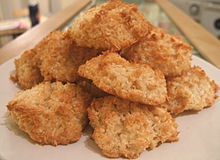Coconut Macaroon
Another alternative for burfee....
1 14 oz Can of Sweetened Condensed Milk
1 tsp of Vanilla Extract
¼ tsp of Almond Extract
2 Egg Whites, at room temperature
¼ tsp of Salt
½ tsp of Cream of Tartar
2) Lay a couple of baking sheets with parchment paper and set aside.
3) In the bowl of an electric mixer, fitted with a whisk attachment, whisk the eggs, salt and cream of tartar until very stiff peaks.
4) Meanwhile in a large bowl mix together the remaining ingredients until the condensed milk is incorporated well throughout the shredded coconut.
5) Using a small ice cream scoop, drop the macaroons about an inch apart on the prepared baking sheets. Bake for about 30 minutes or until golden brown and crisp.
6) Let cool on the baking sheet for 5 minutes before transferring to a wire rack to cool completely.
About Macroon:
A macaroon (/mækəˈruːn/ mak-ə-roon) is a type of light, baked confection, described as meringue-like cookies depending on their consistency. The original macaroon was a "small sweet cake consisting largely of ground almonds"[1] similar to Italian amaretti.
The English word macaroon and French macaron come from the Italian maccarone or maccherone. This word is itself derived fromammaccare, meaning to bruise, used here in reference to the almond paste which is the principal ingredient.
Most recipes call for egg whites (usually whipped to stiff peaks), almonds, coconut, or nuts. Almost all call for sugar. Macaroons are sometimes baked on edible rice paper placed on a baking tray.
Scottish
The Scottish macaroon is a sweet confection with a thick velvety centre covered in chocolate and topped with roasted coconut. Traditionally they were made with cold leftovers of mashed potatoes and sugar loaf. When the macaroon bar became commercial the recipe no longer used mashed potato because of shelf life limitations. The modern macaroon is made from a combination (depending on producer) of: Sugar, Glucose, Water and Egg White. These ingredients make a fondant centre. This recipe was reportedly discovered by accident in 1931, when confectioner John Justice Lees was said to have botched the formula for making a chocolate fondant bar and threw coconut over it in disgust, producing the first macaroon bar.
North American
In North America, the coconut macaroon is the better known variety. Commercially made coconut macaroons are generally dense, moist and sweet, and often dipped in chocolate. Homemade macaroons and varieties produced by smaller bakeries are commonly light and fluffy. Macaroons made with coconuts are often piped out with a star shaped tip, whereas macaroons made with nuts are more likely shaped individually due to the stiffness of the dough. Because of their lack of wheat and leavening ingredients, macaroons are often consumed during Passover in many Jewish homes.
Coconut macaroon
A coconut macaroon is a type of macaroon most commonly found in Australia, the United States, The Netherlands (Kokosmakronen) and Germany, and is directly related to the Scottish macaroon. Its principal ingredients are egg whites, sugar and shredded dried coconut. It is closer to a soft cookie than its meringue cousin, and is equally sweet. Many varieties of coconut macaroons are dipped inchocolate, typically milk chocolate. Versions dipped in dark chocolate or white chocolate are also becoming more commonly available. Nuts are often added to coconut macaroons, typically almond slivers, but occasionally pecans, cashews or other nuts. In Australia, a blob of raspberry jam or glacé cherries are often concealed in the centre of the macaroon prior to cooking.
Dominican
Macaroons in the Dominican Republic are very dark. Grated coconut is mixed with ginger and cinnamon.
French
In France, the coconut macaroon is known as the "congolais".[7][8] Another name for the coconut macaroon is "le rocher à la noix de coco". The almond flour version is simply called "le macaron" in French.
Spanish
Puerto Rican
In Puerto Rico, coconut macaroons are called besitos de coco (little coconut kisses). A few variations of besitos de coco can be found on the island, the most popular ones including lemon zest and vanilla as additional ingredients.
Indian
Tuticorin and Mangalore have their own varieties of macaroon made with cashews and egg whites, adapted from those introduced in colonial times.
Ireland
A macaroon chocolate bar is made by Wilton Candy in Co. Kildare, Ireland. The description on the packaging is "macaroon pieces in Irish milk chocolate." It was first made in 1937.
Turkish
Acıbadem kurabiyesi is a traditional Turkish cookie made of almonds, sugar and egg whites. The traditional recipes include a small amount of bitter almonds, which gives this cookie its name. Because bitter almonds are not readily available, almond extract is typically used as a substitute. These cookies are part of the stock-in trade of almost every bakery in Turkey, as they are seldom made at home.
Ingredients:
1 14 oz Bag of Sweetened Shredded Coconut1 14 oz Can of Sweetened Condensed Milk
1 tsp of Vanilla Extract
¼ tsp of Almond Extract
2 Egg Whites, at room temperature
¼ tsp of Salt
½ tsp of Cream of Tartar
Method:
1) Preheat your oven to 325 degrees.2) Lay a couple of baking sheets with parchment paper and set aside.
3) In the bowl of an electric mixer, fitted with a whisk attachment, whisk the eggs, salt and cream of tartar until very stiff peaks.
4) Meanwhile in a large bowl mix together the remaining ingredients until the condensed milk is incorporated well throughout the shredded coconut.
5) Using a small ice cream scoop, drop the macaroons about an inch apart on the prepared baking sheets. Bake for about 30 minutes or until golden brown and crisp.
6) Let cool on the baking sheet for 5 minutes before transferring to a wire rack to cool completely.






0 Comments